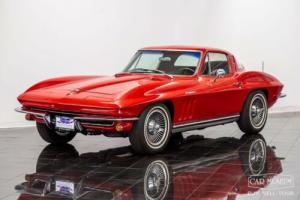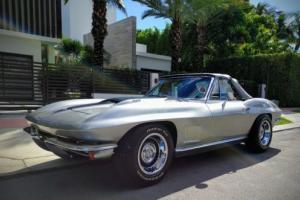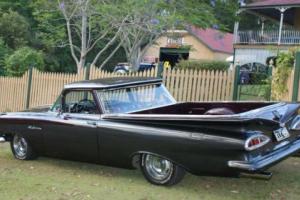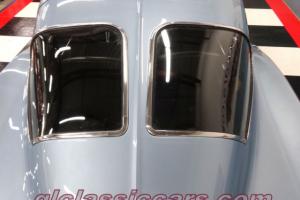Classic Cars / Chevrolet / Car for sale
1963 Split Window Coupe Corvette Stingray
Sale price: $43,198.00 make an offer
Seller's notes: "RARE EXAMPLE OF AN ORIGINAL ICONIC CORVETTE.ATTENTION COLLECTORS AND ENTHUSIAISTS!"
Sale type: Fixed price listing
Technical specifications, photos and description:
- Year:
- 1963
- Mileage:
- 76,882
- Engine:
- 327ci V8 250HP
- Got questions?
- Ask here!
1963 Split Window Coupe Corvette Stingray for sale
Current customer rating:Proudly Presents1963 Chevrolet Corvette 'Split Window' CoupeThis Gem justifiably called a "garage find"The most Iconic and Coveted Corvette Ever!
True to its roots. this Corvette isMATCHING NUMBERS327ci Turbo Fire V8 250HP
Powerglide Automatic Transmission
Power Brakes
Power Steering
Power Windows
76882 Original MilesMostly Everything under hood is either Correct or Original. Notice the Carter Carburetor. Original!
Manifolds. Original!
Heat Shields. Original!Alternator has been replaced over time but a correct one can easily be obtained. This '63 Coupe has spent most of its young life out West where it has been extremely well preserved. Over the years. other than regular maintenance and the typical replacement of wearable parts this 'Vette has stayed true to form and authentic. Exterior was refreshened with a more recent quality and correct Silver Blue Paint same as born with. otherwise mostly everything else is as it was. Very nice and great looking from any distance. this Corvette will please any crowd. Like we mentioned. this Coupe still has its original trim and chrome so a bit of patina is expected. The interior is original and shows abit of wear as it should and as you would want anyways given these cars tend to be more desirable as original and untouched. The dash pad has a crack on the vinyl top portion and the carpet on driver's side is worn thru. There are some soft items we have for the 'Vette and we will include with the car for the new owner. We went on the Corvette Registry and did some research; This particular Corvette has the following stats. M35=POWERGLIDE TRANSMISSION=3. 36 BUILTA31=POWER WINDOWS=3. 42 BUILTJ50=POWER BRAKES=3. 36 BUILTN40=POWER STEERING=3. 36 BUILTOBVIOUSLY THESE STATS ARE FOR BOTH CONVERTIBLE AND COUPE. KEEP IN MIND THAT A SILVER BLUE SPLIT WINDOW COUPE WITH THESE OPTIONS HAS A MUCH LOWER PRODUCTION NUMBER AND IS ONE OF VERY FEW. Call us for details. br>This Corvette won't last long.
Thank you for looking. ood Luck and Happy Bidding.
HistoryOrigin and development The 1959 Corvette Stingray concept and 1960 XP-700 show car in the front and the 1963 Corvette convertible and fastback in the back.
The 1963 Sting Ray production car's lineage can be traced to two separate GM projects: the Q-Corvette. and perhaps more directly. Mitchell's racing Stingray. The Q-Corvette. initiated in 1957. envisioned a smaller. more advanced Corvette as a coupe-only model. boasting a rear transaxle. independent rear suspension. and four-wheel disc brakes. with the rear brakes mounted inboard. Exterior styling was purposeful. with peaked fenders. a long nose. and a short. bobbed tail.
Meanwhile. Zora Arkus-Duntov and other GM engineers had become fascinated with mid and rear-engine designs. It was during the Corvair's development that Duntov took the mid/rear-engine layout to its limits in the CERV I concept. The Chevrolet Experimental Research Vehicle was a lightweight. open-wheel single-seat racer. A rear-engined Corvette was briefly considered during 1958-60. progressing as far as a full-scale mock-up designed around the Corvair's entire rear-mounted power package. including its complicated air-cooled flat-six as an alternative to the Corvette's usual water-cooled V-8. By the fall of 1959. elements of the Q-Corvette and the Stingray Special racer would be incorporated into experimental project XP-720. which was the design program that led directly to the production 1963 Corvette Sting Ray. The XP-720 sought to deliver improved passenger accommodation. more luggage space. and superior ride and handling over previous Corvettes.
While Duntov was developing an innovative new chassis for the 1963 Corvette. designers were adapting and refining the basic look of the racing Stingray for the production model. A fully functional space buck (a wooden mock-up created to work out interior dimensions) was completed by early 1960. production coupe styling was locked up for the most part by April. and the interior. instrument panel included was in place by November. Only in the fall of 1960 did the designers turn their creative attention to a new version of the traditional Corvette convertible and. still later. its detachable hardtop. For the first time in the Corvette's history. wind tunnel testing helped refine the final shape. as did practical matters like interior space. windshield curvatures. and tooling limitations. Both body styles were extensively evaluated as production-ready 3/8-scale models at the Cal Tech wind tunnel.
The vehicle's inner structure received as much attention as the aerodynamics of its exterior . Fiberglass outer panels were retained. but the Sting Ray emerged with nearly twice as much steel support in its central structure as the 1958-62 Corvette. The resulting extra weight was balanced by a reduction in fiberglass thickness. so the finished product actually weighed a bit less than the old roadster. Passenger room was as good as before despite the tighter wheelbase. and the reinforcing steel girder made the cockpit both stronger and safer.
Design and engineering 1963 Corvette Sting Ray CoupeThe first-ever production Corvette coupe. a futuristic fastback. sported a for its time period unusual styling element - a divided rear window. The rear window's basic shape had been originally conceived by Bob McLean for the Q-model. The rest of the Sting Ray design was equally stunning. Quad headlamps were retained but newly hidden - the first American car so equipped since the 1942 DeSoto. The lamps were mounted in rotating sections that matched the sharp-edged front end with the "eyes" closed. The Corvette continued to use hidden headlamps until the C6 model debuted in 2005. Coupe doors were cut into the roof. which made entry/exit easier in such a low-slung closed car. Faux vents were located in the hood and on the coupe's rear pillars; functional ones had been intended but were cancelled due to cost considerations. The fastback design was later adopted by another GM car. the third-generation Buick Riviera that debuted in 1971. with the "Boattail" nickname applied to the larger Buick design.
1963 Corvette Sting Ray interiorThe Sting Ray's interior carried a new interpretation of the twin-cowl Corvette dash motif used since 1958. It was also more practical. now incorporating a roomy glovebox. an improved heater. and the cowl-ventilation system. A full set of round gauges included a huge speedometer and tachometer. The control tower center console returned. somewhat slimmer but now containing the clock and a vertically situated radio. Luggage space was improved as well. though due to a lack of an external trunklid. cargo had to be loaded behind the seats. The spare tire was located at the rear in a drop-down fiberglass housing beneath the gas tank (which now held 20 gallons instead of 16). The big. round deck emblem was newly hinged to double as a fuel-filler flap. replacing the previous left-flank door.
Though not as obvious as the car's radical styling. the new chassis was just as important to the Sting Ray's success. Maneuverability was improved thanks to the faster recirculating_ball. or "Ball-Race". steering. and a shorter wheelbase. The latter might ordinarily imply a choppier ride. but the altered weight distribution partly compensated for it. Less weight on the front wheels also meant easier steering. and with some 80 additional pounds on the rear wheels. the Sting Ray offered improved traction. Stopping power improved. too. Four-wheel cast-iron 11-inch drum brakes remained standard but were now wider. for an increase in effective braking area. Sintered-metallic linings. segmented for cooling. were again optional. So were finned aluminum drums. which not only provided faster heat dissipation (and thus better fade resistance) but less unsprung weight. Power assist was available with both brake packages. Evolutionary engineering changes included positive crankcase ventilation. a smaller flywheel. and an aluminum clutch housing. A more efficient alternator replaced the old-fashioned generator.
1963 Corvette Sting Ray Convertible & CoupeThe independent rear suspension Duntov created for Sting Ray was essentially a frame-mounted differential with U-jointed half-shafts tied together by a transverse leaf spring - a design derived from the CERV I concept. Rubber-cushioned struts carried the differential. which reduced ride harshness while improving tire adhesion. especially on rougher roads. The transverse spring was bolted to the rear of the differential case. A control arm extended laterally and slightly forward from each side of the case to a hub carrier. with a trailing radius rod mounted behind it. The half-shafts functioned like upper control arms. The lower arms controlled vertical wheel motion. while the trailing rods took care of fore/aft wheel motion and transferred braking torque to the frame. Shock absorbers were conventional twin-tube units. Considerably lighter than the old solid axle. the new rear suspension array delivered a significant reduction in unsprung weight. which was important since the 1963 model would retain the previous generation's outboard rear brakes. The new model's front suspension would be much as before. with unequal-length upper and lower A-arms on coil springs concentric with the shocks. plus a standard anti-roll bar. Steering remained the conventional recirculating-ball steering design. but it was geared at a higher 19. 6:1 overall ratio (previously 21. 0:1). Bolted to the frame rail at one end and to the relay rod at the other was a new hydraulic steering damper (essentially a shock absorber). which helped soak up bumps before they reached the steering wheel. What's more. hydraulically assisted steering would be offered as optional equipment for the first time on a Corvette - except on cars with the two most powerful engines -and offer a faster 17. 1:1 ratio. which reduced lock-to-lock turns from 3. 4 to just 2. 9.
Drivetrains were carried over from the previous generation. comprising four small block 327 V8s. three transmissions. and six axle ratios. Carbureted engines came in 250. 300. and 340-horsepower versions. As before. the base and optional units employed hydraulic lifters. a mild camshaft. forged-steel crankshaft. 10. 5:1 compression. single-point distributor. and dual exhausts. The 300-bhp engine produced its extra power via a larger four-barrel carburetor (Carter AFB instead of the 250's Carter WCFB). plus larger intake valves and exhaust manifold. Again topping the performance chart was a 360-bhp fuel-injected V8. available for an extra $430. 40. The car's standard transmission remained the familiar three-speed manual. though the preferred gearbox continued to be the Borg-Warner manual four-speed. delivered with wide-ratio gears when teamed with the base and 300-bhp engines. and close-ratio gearing with the top two powerplants. Standard axle ratio for the three-speed manual or Powerglide automatic was 3. 36:1. The four-speed gearbox came with a 3. 70:1 final drive. but 3. 08:1. 3. 55:1. 4. 11:1. and 4. 56:1 gearsets were available. The last was quite rare in production. however.
Corvette's designers and engineers - Ed Cole. Zora Arkus-Duntov. Bill Mitchell. and others knew that after 10 years in its basic form. albeit much improved. it was time to move on. By decade's end. the machinery would be put into motion to fashion a fitting successor to debut for the 1963 model year. After years of tinkering with the basic package. Bill Mitchell and his crew would finally break the mold of Harley Earl's original design once and for all. He would dub the Corvette's second generation "Sting Ray" after the earlier race car of the same name (but now spelled out in separate words).
The C2 was designed by Larry Shinoda under the direction of GM chief stylist Bill Mitchell. Inspiration was drawn from several sources: the contemporary Jaguar E-Type. one of which Mitchell owned and enjoyed driving frequently; the radical Stingray Racer Mitchell designed in 1959 as Chevrolet no longer participated in factory racing; and a Mako shark Mitchell caught while deep-sea fishing. Zora Arkus-Duntov ("father of the Corvette") disliked the split rear window (which also raised safety concerns due to reduced visibility) and it was discontinued in 1964. as were the fake hood vents.
Model year changes1963The 1963 Corvette Sting Ray not only had a new design. but also newfound handling prowess. The Sting Ray was also a somewhat lighter Corvette. so acceleration improved despite unchanged horsepower. 21. 13 units would be built for the 1963 model year. which was up 50 percent from the record-setting 1962 version. Production was divided almost evenly between the convertible and the new coupe - 10. 19 and 10. 94. respectively - and more than half the convertibles were ordered with the optional lift-off hardtop. Nevertheless. the coupe wouldn't sell as well again throughout the Sting Ray years. In fact. not until 1969 (by which time the coupe came with removable T-tops) did the closed Corvette sell better than the open one. Equipment installations for 1963 began reflecting the market's demand for more civility in sporting cars. - the power brake option went into 15 percent of production. power steering into 12 percent. On the other hand. only 278 buyers specified the $421. 80 air conditioning; leather upholstery - a mere $80. 70 - was ordered on only about 400 cars. The beautiful cast aluminum knock-off wheels. manufactured for Chevy by Kelsey-Hayes. cost $322. 80 a set. but few buyers checked off that option. However. almost 18. 00 Sting Rays left St. Louis with the four-speed manual gearbox - better than four out of every five.All 1963 cars had 327cid engines. which made 250 hp (186 kW) standard. with optional variants that made 300 hp (224 kW). 340 hp (254 kW) and 360 hp (268 kW). The most powerful engine was the Rochester fuel injected 327cid V8. which made 360 hp (272 kW). Options available on the C2 included AM-FM radio (mid 1963). air conditioning and leather upholstery. New for the 1963 model year was an optional electronic ignition. the breakerless magnetic pulse-triggered Delcotronic. first offered by Pontiac on some 1963 models.
FROM THE CONCEPTCARZ. COM SITE
Data based on 466 auction sales
•Average Sale Value : $73. 72•Lowest Sale Value : $9. 88•Highest Sale Value : $1. 50. 00CONVERTIBLES: $57. 05.
COUPES: $91. 95.
Engines
Average Sale
327 CID | 250 HP$130. 90 327 CID | 300 HP$80. 57 327 CID | 304 HP$52. 03 327 CID | 340 HP$79. 50
HERE'S A BIT OF CORVETTE HISTORY.
In 1963. Corvette introduced its all new Corvette Coupé and Convertible models called the Sting Rays. The car incorporated a boat-tail taper that was common of sporting roadster of the 1930s. The back featured a Bugatti Atlantique and Bertone BAT inspired split rear-window. This styling was replaced in 1964 with a single piece because of drivers complaining about visibility problems. The headlights were concealed in the front and would 'pop' out when in use.
New plants in St. Louis. Missouri were opened to keep pace with the vehicles popularity.
This was the very first time Corvette was available as a hardtop coupe model as well as the traditional convertible. The wheelbase was shortened by four inches to 98 inch. This. along with independent rear suspension. improved the handling and maneuverability. The steering ratio decreased from 3. 4 to 2. 9 turns-to-lock. Hydraulically assisted power steering was also offered for the first time. The drum brakes were still used. The optional sintered metallic linings and finned aluminum brake drums were offered and allowed greater fade resistance and better cooling.
During the development process. the car was called the XP-720.
The Corvette was launched in 1953 with 300 hand-built polo white convertibles built during the first year. It was an instant styling sensation that lacked the performance to back up its impressive looks. This was quickly remedied and by 1955 a new V-8 was available. Body changes in 1956 and 1958 improved the look of the car but maintained the same general design as the original. In 1963 a radical new body style was introduced.
Influenced by Bill Mitchell's racing Stingray and the Q Corvette designs from 1957. the new body was an absolute sensation. Elements of the Q Corvette and the Stingray Special racer were incorporated into an experimental project called XP-720. which was the design program that led directly to the production 1963 Corvette String Ray.
The XP-720 sought to deliver improved passenger accommodation. more luggage space. and superior ride and handling over the previous Corvettes. The Q Corvette envisioned a smaller. more advanced Corvette as a coupe-only model. boasting a rear transaxle. independent rear suspension. and four-wheel disc brakes. with the rear brakes mounted inboard. Exterior styling was purposeful. with peaked fenders. a long nose. and a short. bobbed tail.
This particular example was ordered with ever available option. including air conditioning. Only 278 coupes were built with air conditioning. Freshly restored in Saddle Tan. this car was built in the last week of production for 1963. The 1963 Split Window Coupe is widely recognized as one of the most iconic designs to ever have been produced. The Corvette was completely redesigned for 1963 incorporating independent rear suspension and all new styling. The 1963 Sting Ray coupe featured a unique split rear window that is unique only to this year. In 1964 the center bar was removed from the window.
When the 1963 Corvette was introduced in late 1962. it featured an all new body style derived from a race car built by GM styling guru Bill Mitchell. The new styling was a big hit. its angular body. wîth a minimum of bright work and a distinctive split rear window on the coupe version. This was the first year that Corvette offered both convertible and coupe body forms. nonfunctional vents were featured on both the sides and the hood and it was the only year for the split window. There are fewer split window models today compared to how many were original produced because many owners. who found the look controversial. removed the split and installed a one-piece. 1964 rear window.
The body was mounted on a new chassis wîth independent rear suspension. However. under the hood was the familiar 327 cid V-8 from the previous year. The standard engine produced a somewhat lackluster 250 horsepower. but the top fuel-injected model would produce up to 260 h. p.
The name Corvette. wîth the extended name 'Corvette Sting Ray'. would prove widely popular. Base price for the coupe was $4. 57. 00 while the convertible ran $4. 37. 00. The 1963 model year would produce 10. 94 coupes and 10. 19 convertibles.
Source - Lemay MuseumFastback Coupe
The 1963 Chevrolet Corvette is famous for its split rear window and are among the most sought after and prized Corvettes.
If you have any questions about this or
any of our other auctions
please feel free to contact us
via e-mail sales@glclassiccars. com
or you can call us at (800) 510-3797.
Thank you for your interest and
we look forward to hearing from you.
1963 Chevrolet Corvette auction sales and data. Auction Data | Search >> Auction Companies >> Automakers >> Chevrolet Average Sale Price by Calendar Year201420132012201120102009200820072006High Sale2365003100002550001705004000001050000222500280500230050Average Sale9554984768686176219369061100579705718931474797Low Sale24200225002750028500938833000282503650040700Average Sale Price by Calendar YearHigh SaleAverage SaleLow Sale201420132012201120102009200820072006$1050K$787. 5K$525K$262. 5K$0K$236. 00$95. 49$24. 00$310. 00$84. 68$22. 00$255. 00$68. 17$27. 00$170. 00$62. 93$28. 00$400. 00$69. 61$9. 88$1. 50. 00$100. 79$33. 00$222. 00$70. 71$28. 50$280. 00$89. 14$36. 00$230. 50$74. 97$40. 00close1963 Chevrolet Corvette Z06 CoupeSold for $1. 50. 00 at 2009 Mecum
Fuel-injected 327/360 HP. Muncie M20 4-speed transmissionData based on 466 auction sales•Average Sale Value : $73. 72•Lowest Sale Value : $9. 88•Highest Sale Value : $1. 50. 00•Average Sale Value : $65. 10 (disregarding 5% of high and low sales)
BodystylesAverage Sale*Average SaleConvertible$57. 05 $52. 17*closeAverage calculated with disregard to the highest . 05% of sales. Fastback Coupe$91. 95 $78. 74*closeAverage calculated with disregard to the highest . 05% of sales. *Average sale disregarding a percentage of high sales.
EnginesAverage Sale327 CID | 250 HP$130. 90 327 CID | 300 HP$80. 57 327 CID | 304 HP$52. 03 327 CID | 340 HP$79. 50 Features & Options
Automatic Transmission
Center Arm Rest
Chrome Bumper
Clock
Coolant Temp. Gauge
Courtesy Lights
Dual Exhaust
Fender Flares
Front Bucket Seats
Interior Hood Release
Power Steering
Power windows
Radial tires
Rear-Wheel Drive
SPLIT-WINDOW
STINGRAY
Sport Steering Wheel
Tachometer
V-Style Engine
Photo GalleryAdditional InformationWarrantyAS IS - NO WARRANTY
This vehicle is being sold as is. where is with no warranty. expressed written or implied. The seller shall not be responsible for the correct description. authenticity. genuineness. or defects herein. and makes no warranty in connection therewith. No allowance or set aside will be made on account of any incorrectness. imperfection. defect or damage. Any descriptions or representations are for identification purposes only and are not to be construed as a warranty of any type. It is the responsibility of the buyer to have thoroughly inspected the vehicle. and to have satisfied himself or herself as to the condition and value and to bid based upon that judgement solely. The seller shall and will make every reasonable effort to disclose any known defects associated with this vehicle at the buyer's request prior to the close of sale. Seller assumes no responsibility for any repairs regardless of any oral statements about the vehicle.
WE ALWAYS DO OUR BEST TO DESCRIBE EXACTLY WHAT WE SEE AND KNOW ABOUT THE ITEM YOU'RE BIDDING ON. "IF YOU DON'T KNOW OR ARE NOT SURE PLEASE CALL. " Please don't hesitate to contact us.
tel: 800-510-3797
e-mail: sales@glclassiccars. com .
We will be more than happy to speak to you. Thank you
Terms & ConditionsWinning bidder must contact us within 24 hours of auction end. and make arrangements for payment at that time. A $500. 00 deposit is due within 24 hours of end of auction. The remainder is due within 3 business days of Auction end. If no contact is made within 24 hours we reserve the right to re-list the vehicle. sell it to the next high bidder. or sell it otherwise. Most banks and credit unions do not finance vehicles older than 1995 or with more than 100K miles. Make sure if financing. your financial institution accepts the year and miles of this vehicle before bidding. Please arrange financing prior to bidding.
Buyer is responsible for pickup or shipping of this vehicle. If you wish to have it shipped using a service. we will gladly cooperate. you can locate shippers by doing a search for `auto shippers`.
If you are not sure about something. Please ASK. Do not assume anything not listed is included. We reserve the right to cancel bids for excessive negative feedback. We reserve the right to end the listing if the vehicle is no longer available for sale.
All non-paying high bidders will be reported to Ebay. and negative feedback posted.
PLEASE ONLY BID WHAT YOU ARE WILLING TO PAY. IF THE RESERVE IS NOT MET. WE MAY CONTACT THE HIGH BIDDER TO OFFER THE SECOND CHANCE OPTION.
Fee and Tax Information:
Any and all questions. please don't hesitate to contact us directly.
See our other listingsAlso published at eBay.com
Want to buy this car?
Comments and questions to the seller:
Other classic Chevrolet cars offered via internet auctions:
 price: $82,425.001965 Chevrolet Corvette Fuelie
price: $82,425.001965 Chevrolet Corvette Fuelie price: $69,000.001966 Chevrolet Corvette
price: $69,000.001966 Chevrolet Corvette price: $21,500.001959 Chevrolet Biscayne
price: $21,500.001959 Chevrolet Biscayne price: $39,500.001959 CHEVROLET ELCAMINO
price: $39,500.001959 CHEVROLET ELCAMINO
Latest arrivals:
-
$35,995.000
-
$49,999.000
-
$21,995.000
-
$31,995.000
-
$37,999.000
-
$126,000.000
-
$49,995.000
-
$44,995.000
-
$29,900.000
-
$10,950.000
-
$29,000.000
-
$34,388.000
-
$39,398.000
-
$39,400.000
-
$41,301.000
-
$28,000.000
-
$10,601.000
-
$26,500.000
-
$64,900.000
-
$77,600.000









































